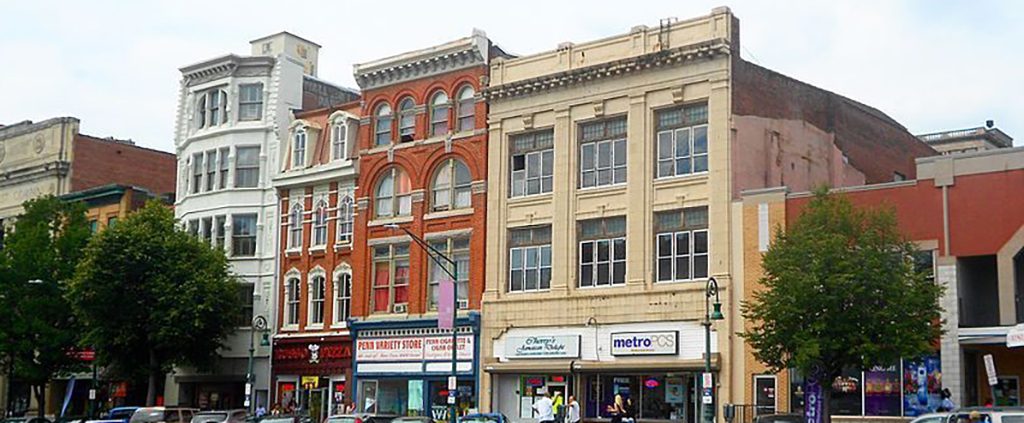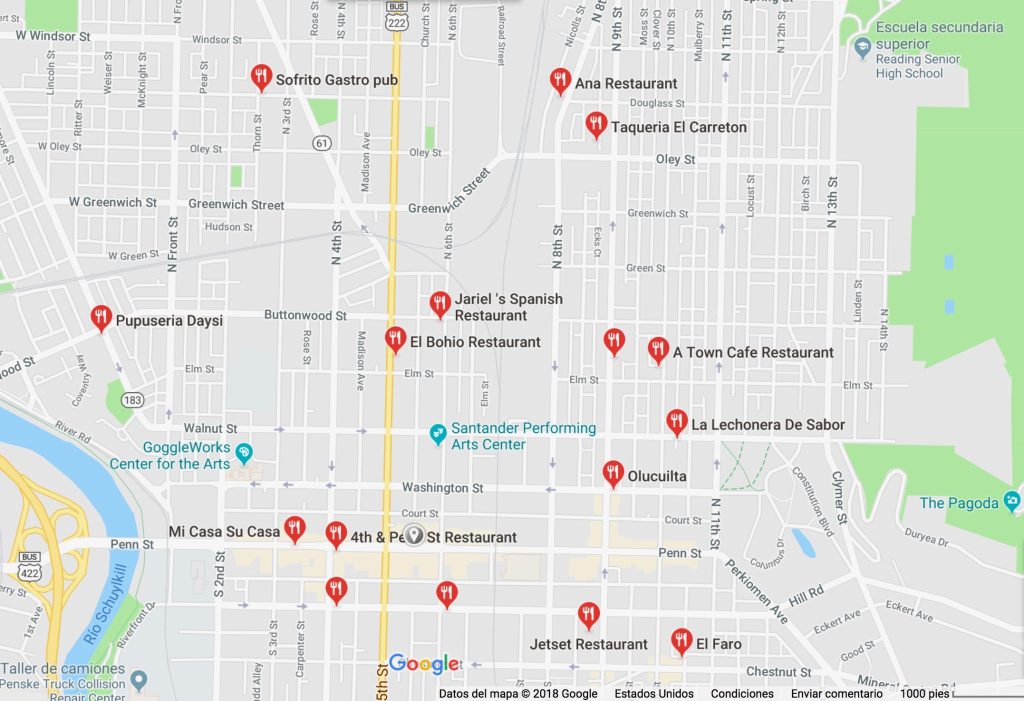
Empresas y servicios de una comunidad
En este mapa de Reading vemos varios restaurantes latinos. ¡Pero una comunidad es más que restaurantes! Hay otras empresas también.

Construir una lista de vocabulario
As you complete this exercise, you’ll be building much of the vocabulary list for this lesson. Match the place (left column) with the best definition or activity (right column). Use your skills at recognizing cognates, recycling previously learned vocabulary, and logic (process of elimination) to help you complete this exercise. Find the complete list at Quizlet.
-
- ____ una agencia de viajes
- ____ una bodega
- ____ una cafetería
- ____ un centro comercial
- ____ un cine
- ____ un club
- ____ una escuela
- ____ un gimnasio
- ____ una iglesia
- ____ una mezquita
- ____ un museo
- ____ un parque
- ____ un restaurante
- ____ una sinagoga
- ____ un supermercado
- Aquí yo voy de compras en muchas tiendas.
- Es un lugar para ceremonias religiosas islámicas
- un lugar para ceremonias religiosas cristianas.
- Es un lugar grande para comprar comida<
- Es un lugar para ceremonias religiosas judías.
- Es un lugar pequeño para comprar comida.
- Yo bebo café aquí.
- Yo busco información turística aquí.
- Yo como aquí.
- Yo estudio aquí.
- Yo hago ejercicio aquí.
- Yo salgo con mis amigos para bailar.
- Yo juego al fútbol o hago un picnic aquí.
- Yo veo películas aquí.
- Yo voy aquí para ver arte
Entender y personalizar el vocabulario
Un paseo por la ciudad de Eva
Watch the video below: NEEM Básico – Unidad 6 Un paseo por mi ciudad – subtitulado.
Listen to Eva as she takes you on a tour of her city, Ponferrada. Scroll down so you block the subtitles the first time or two you watch. You can look at the subtitles after that if you need to. A good listening strategy is to read the questions and/or activities before you listen. Take a couple of minutes to do that.
- ¿Cómo es Ponferrada?
- ¿Dónde está Ponferrada?
- ¿Cómo es el barrio de Eva?
- Escribe una frase comparando Reading y Ponferrada.
- Escribe una frase comparando tu ciudad o pueblo y Ponferrada.
- ¿De qué organizaciones y empresas habla Eva en el vídeo?
-
- Una agencia de viajes
- Un café
- Una cafetería
- Un castillo medieval
- Una estación de radio
- Un museo de la radio
- Una oficina de turismo
- Una plaza
- Un restaurante
- Una sinagoga
- Unas tiendas
Daily Routine: Irregular Verbs
Some of the verbs we learn in this lesson are irregular. Can you remember some irregular verbs that you’ve learned before? Work with a partner to list them in two categories—verbs whose yo forms end in -oy and verbs whose yo forms end in -go. When you finish, look at the verbs in the right column above (letters A to O) and add the new -oy and -go verbs you find there to your two lists. Below you’ll see the new -oy and -go verbs with their full conjugations plus one other irregular verb, ver
| Poner = To put | |
|---|---|
| yo pongo | nosotros ponemos |
| tú pones | vosotros ponéis |
| él pone | ellos ponen |
| Salir = To go out | |
|---|---|
| yo salgo | nosotros salimos |
| tú sales | vosotros salís |
| él sale | ellos salen |
| Ver = To see | |
|---|---|
| yo veo | nosotros vemos |
| tú ves | vosotros veis |
| él ve | ellos ven |
| Ir = To go | |
|---|---|
| yo voy | nosotros vamos |
| tú vas | vosotros vais |
| él va | ellos van |
| Estar = To be (location verb) | |
|---|---|
| yo estoy | nosotros estamos |
| tú estás | vosotros estáis |
| él está | ellos están |
Since the verbs ir and salir often are followed by the words a and de, we have one more thing to do, and that’s learning about Spanish’s two required contractions. Watch: Contractions in Spanish and take notes on what you learn there.
Nuestras actividades
Write sentences that tell what you, your friend, and your family do. Use the verbs on the list below and add two things to each sentence: a place where the activity logically happens and an expression that tells when the activity happens. Careful with al and del. When you finish, share your sentences out loud with a classmate.
Lista de verbos:
- hacer ejercicio
- ir
- jugar a los videojuegos
- salir con mis amigos
- ver una película
Cuando:
- los lunes
- los sábados
- todos los días
- frecuentemente
- mucho
- poco, etc.
Donde:
- Mira la lista de vocabulario arriba en la página.
¿Eres buen actor?
Mime an activity or a place from the vocabulary list on this page or something you learned earlier in this course. Your classmates will guess what the activity or place is.
¡Necesitamos practicar mucho!
For speakers of English, conjugating verbs in Spanish and other Romance languages, especially irregular ones, requires a lot of practice, just as playing a musical instrument or sport, singing, or learning a choreographed dance routine do. Practice conjugation for one or two short chunks of time most days of the week. You can make a personalized quiz for yourself at SPALEON’s website. Stick to verbs you know for now. When you practice, be sure to say the words out loud. Some people find that writing them is helpful, too.
Voces de nuestra comunidad: El trabajo
- Download the handout Voces de la comunidad: El trabajo.
- Listen to the video Voces de nuestra comunidad: El trabajo and answer the questions on the handout. You won’t get all of the information the first or even second time you listen. That’s okay.
- After you’ve listened twice and taken notes, you may view the video Voces de nuestra comunidad: El trabajo with subtitles to check your work.
- Compare your answers with those of your classmates
Indicar la dirección
When we talk about business and organizations, we often need to indicate their addresses. Word order for addresses is different in Spanish. Look at this example and note differences from how we give addresses in the United States. Don’t worry about ZIP codes; their placement varies from one Spanish-speaking country to the other.
Modelos:
- Salón de Belleza Miss Rizos, Calle Arzobispo Meriño 217, Santo Domingo 10210, La República Dominicana
- Grupo Modelo, Avenida Hermanos Serdán No. 159, 72320, Puebla, México
- Freixenet, Plaza Joan Sala 2, 08770 Sant Sadurní d’Anoia, España
Some Latinos in the United States, when they give addresses in Spanish, modify the word order to match the conventions of the dominant culture.
De visita a Pamplona
With a classmate, examine the website Guía De Pamplona and its directory of businesses in Pamplona (una ciudad en el norte de España). Take a few minutes to read the listings of some of the businesses. Compile a five-sentence list of businesses, addresses, and a brief description of what each business does. Choose carefully and use familiar words and cognates so that your classmates will understand. Include the business name, its address, and what people (la gente—hint: this word is singular) do there. Don’t include the ZIP code, the five-digit number, in the address.
Modelos:
- Ogi Pan Yamaguchi está en Calle Sancho Ramírez, número 3. La gente toma café aquí.
- Theara Decoración está en Calle Arbizu, número 15. La gente busca soluciones para la decoración de sus casas aquí.
After completing this theme, I can …
- in Spanish, list businesses and organizations that commonly exist in communities.
- in Spanish, use irregular verbs to express common activities and where and when they happen.
- give street addresses in Spanish.
- and navigate an online business directory in Spanish.
